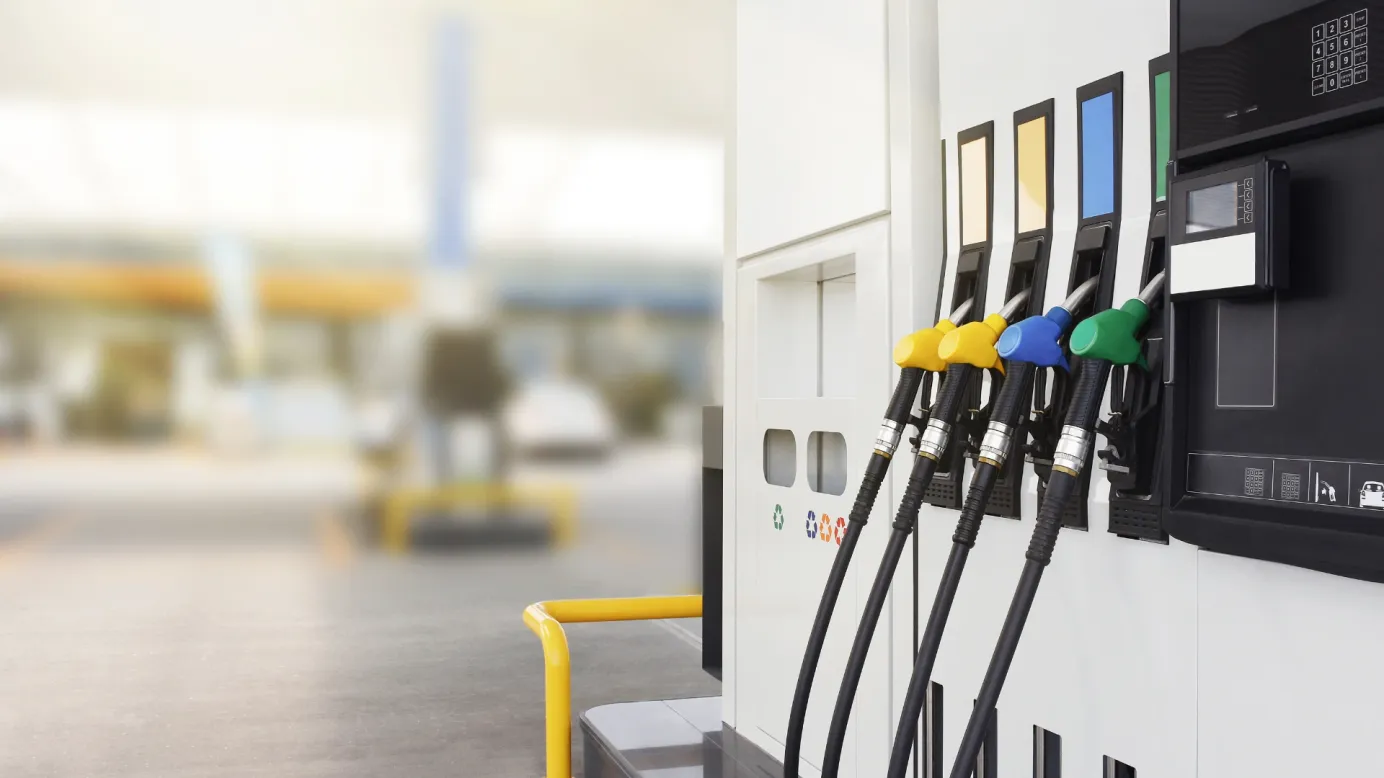Kartu Bahan Bakar untuk Karyawan: Manfaat, Fasilitas Pajak & Cara Kerjanya
Jelajahi nilai kartu bahan bakar bagi karyawan-bagaimana cara kerjanya, mengapa kartu ini penting, dan manfaat pajak yang ditawarkannya. Temukan bagaimana Empuls membantu perusahaan meluncurkan kartu bahan bakar sebagai tunjangan tambahan yang mulus, sesuai, dan ramah karyawan.
Di halaman ini
- Apa yang dimaksud dengan kartu bahan bakar dan bagaimana cara kerjanya?
- Mengapa kartu bahan bakar perusahaan masuk akal-untuk kedua belah pihak
- Manfaat kartu bahan bakar untuk karyawan
- Bagaimana Empuls mempermudah penawaran kartu bahan bakar sebagai manfaat tambahan bebas pajak
- Menerapkan kebijakan kartu bahan bakar di organisasi Anda
- Kartu bahan bakar adalah cara praktis untuk mendukung karyawan Anda
Dengan naiknya harga bahan bakar dan waktu tempuh yang lebih lama, karyawan saat ini menghabiskan lebih banyak waktu untuk datang ke kantor. Hal ini menambah stres dan kompleksitas logistik bagi bisnis, terutama bagi mereka yang memiliki staf lapangan, tim gabungan, atau karyawan yang menggunakan kendaraan pribadi untuk bekerja.
Di situlah kartu bahan bakar karyawan berperan-bukan hanya sebagai tunjangan, tetapi juga sebagai manfaat praktis. Kartu ini membantu perusahaan merampingkan penggantian bahan bakar, mengurangi beban kerja administratif, dan menawarkan dukungan yang nyata dan dapat digunakan untuk tenaga kerja mereka.
Platform modern seperti Empuls menyederhanakan proses penawaran kartu bahan bakar di bawah tunjangan tambahan bebas pajak, sehingga mudah untuk meluncurkannya, mengelola penggunaan, dan menjaga agar semuanya tetap sesuai. Ini adalah manfaat kecil yang dapat secara signifikan memengaruhi perasaan karyawan terhadap perusahaan mereka.
Apa yang dimaksud dengan kartu bahan bakar dan bagaimana cara kerjanya?
Kartu bahan bakar untuk karyawan - kartu bahan bakar karyawan - adalah kartu prabayar atau pascabayar yang disediakan oleh perusahaan untuk menutupi biaya bahan bakar. Ini adalah alternatif yang lebih inovatif dari metode penggantian tradisional, yang memberikan karyawan akses cepat ke dana bahan bakar dan mengurangi dokumen untuk tim SDM dan keuangan.
Jadi, bagaimana cara kerja kartu bahan bakar untuk karyawan? Karyawan menerima kartu fisik atau digital yang dapat digunakan di stasiun bahan bakar yang bermitra. Tergantung pada pengaturannya, perusahaan dapat mengisi jumlah bulanan tetap atau mengizinkan penggunaan hingga batas tertentu. Beberapa kartu terintegrasi dengan alat pelacakan armada, sehingga ideal untuk staf lapangan dan tim logistik.
Dan jika Anda bertanya-tanya bagaimana cara kerja kartu bahan bakar perusahaan di bagian belakang, ini cukup sederhana. Perusahaan bermitra langsung dengan penyedia kartu bahan bakar atau menggunakan platform tunjangan seperti Empuls untuk mengelola alokasi, melacak pengeluaran, dan mematuhi peraturan pajak. Semuanya transparan, digital, dan mudah dipantau.
Kartu bahan bakar menghilangkan dugaan dari penggantian bahan bakar, memastikan karyawan tidak perlu lagi menanggung biaya perjalanan bisnis dari kantong mereka sendiri.
Mengapa kartu bahan bakar perusahaan masuk akal-untuk kedua belah pihak
Biaya bahan bakar merupakan pengeluaran tetap bagi karyawan yang melakukan perjalanan pulang pergi untuk bekerja, dan mengelola pengeluaran tersebut bisa jadi berantakan - mulai dari mengumpulkan tanda terima hingga merekonsiliasi laporan. Manfaat kartu bahan bakar perusahaan menghilangkan kerumitan tersebut dan menggantinya dengan kemudahan, visibilitas, dan kontrol.
Ini adalah salah satu manfaat langka yang sangat dihargai oleh kedua belah pihak.
Inilah yang diperoleh karyawan:
- Tidak perlu lagi mengeluarkan uang sendiri dan menunggu penggantian biaya
- Akses mudah ke dana bahan bakar-sangat membantu bagi staf lapangan atau pekerja hybrid
- Tabungan bebas pajak jika ditawarkan sebagai bagian dari program tunjangan tambahan yang sesuai
- Lebih bebas untuk fokus pada pekerjaan tanpa mengkhawatirkan biaya perjalanan
Inilah keuntungan yang diperoleh perusahaan:
- Lebih sedikit klaim penggantian yang harus diproses dan diverifikasi
- Kontrol yang lebih besar atas bagaimana biaya terkait perjalanan dikelola
- Visibilitas ke dalam pola pengeluaran bahan bakar di seluruh tim
- Manfaat hemat biaya yang mendukung kepuasan dan retensi karyawan
Ketika Anda menawarkan kartu bahan bakar sebagai manfaat formal, terutama melalui platform terstruktur seperti Empuls, Anda melakukan lebih dari sekadar menutupi biaya bahan bakar-membangun kepercayaan, menawarkan kenyamanan, dan menunjukkan kepada tim Anda bahwa upaya harian mereka sangat berarti.
Manfaat kartu bahan bakar untuk karyawan
Kartu bahan bakar tampak seperti manfaat kecil, namun hal ini membuat perbedaan yang nyata bagi karyawan yang melakukan perjalanan setiap hari atau bepergian untuk bekerja. Program kartu bahan bakar karyawan yang terstruktur dengan baik membantu mengurangi tekanan keuangan dan menawarkan ketenangan pikiran, yang secara langsung memengaruhi keterlibatan dan produktivitas.
Berikut ini adalah penjelasan lebih lanjut mengenai apa yang membuat kartu bahan bakar untuk karyawan menjadi manfaat yang berharga:
1. Akses langsung ke dana bahan bakar
Daripada merogoh dompet dan menunggu penggantian uang, karyawan dapat menggunakan kartu bahan bakar di pompa bensin saat dibutuhkan. Hal ini menghilangkan penundaan, dokumen, dan tindak lanjut yang canggung untuk klaim yang tertunda.
2. Mengurangi tekanan keuangan
Biaya bahan bakar dapat menggerogoti anggaran bulanan karyawan, terutama bagi mereka yang mengandalkan kendaraan pribadi untuk bepergian ke kantor. Kartu bahan bakar memberikan bantalan keuangan ekstra, sehingga karyawan dapat fokus pada tugas-tugas mereka-bukan pada biaya perjalanan yang meningkat.
3. Penghematan pajak di bawah skema manfaat tambahan
Jika disusun dengan benar, tunjangan kartu bahan bakar perusahaan dapat dikualifikasikan sebagai tunjangan tambahan bebas pajak. Ini berarti karyawan dapat menikmati nilai penuh dari tunjangan tersebut tanpa beban pajak tambahan. Platform seperti Empuls membantu mengelola hal ini dengan mudah, memastikan kepatuhan sekaligus meningkatkan nilai yang bisa dibawa pulang.
4. Kemudahan penggunaan dan pelacakan digital
Kartu bahan bakar modern memiliki aplikasi seluler atau dasbor yang memungkinkan karyawan melihat saldo, melacak transaksi, dan memeriksa penggunaan bahan bakar - kapan saja, di mana saja. Transparansi ini membuat manfaatnya lebih mudah digunakan dan dapat dipercaya.
5. Perencanaan dan penganggaran yang lebih baik
Dengan tunjangan bahan bakar yang tetap setiap bulannya, karyawan dapat merencanakan dan mengelola perjalanan mereka dengan percaya diri. Hal ini menciptakan prediktabilitas dan membantu mereka menghindari pengeluaran yang tidak terencana untuk transportasi.
Kartu gas untuk karyawan bukan hanya alat penghemat biaya-ini merupakan manfaat yang menunjukkan bahwa perusahaan memahami tantangan sehari-hari dan bersedia mendukung karyawannya di tempat yang penting.
Bagaimana Empuls mempermudah penawaran kartu bahan bakar sebagai manfaat tambahan bebas pajak
Menawarkan kartu bahan bakar untuk karyawan mungkin tampak seperti tantangan logistik-tetapi tidak harus demikian. Dengan platform seperti Empuls, seluruh proses menjadi ramping, patuh, dan mudah untuk diukur di seluruh organisasi Anda.

Empuls menyatukan semuanya di bawah satu atap, sehingga perusahaan dapat menawarkan kartu bahan bakar sebagai bagian dari program tunjangan tambahan bebas pajak. Hal ini membantu karyawan mengurangi penghasilan kena pajak dan memastikan tim SDM dan keuangan tetap mematuhi pedoman undang-undang.
Mari kita uraikan.
Konfigurasi dan distribusi yang sederhana
Empuls memungkinkan tim HR untuk menentukan tunjangan kartu bahan bakar berdasarkan peran, lokasi, atau departemen. Dana dapat dialokasikan secara bulanan, triwulanan, atau berdasarkan frekuensi perjalanan. Semuanya dikelola secara digital, sehingga tidak perlu lagi mengejar tanda terima atau menyetujui klaim secara manual.
Manajemen tunjangan tambahan yang sesuai dengan peraturan perpajakan
Kartu bahan bakar yang ditawarkan melalui Empuls selaras dengan peraturan pajak India, sehingga memenuhi syarat sebagai tunjangan yang tidak kena pajak. Karyawan mendapatkan nilai lebih dalam gaji yang dibawa pulang, dan perusahaan terhindar dari komplikasi pajak atau risiko audit.
Platform terpadu untuk semua manfaat
Empuls tidak hanya berhenti pada bahan bakar. Empuls juga menawarkan manfaat tambahan lainnya seperti kartu makan, LTA, tunjangan gadget, dan penggantian biaya kesehatan. Semuanya dikelola melalui satu antarmuka, sehingga menghemat waktu dan mengurangi biaya administrasi.
Pelacakan dan pelaporan waktu nyata
Admin dapat melihat pola penggunaan, memantau jumlah yang dialokasikan, dan membuat laporan kapan saja. Visibilitas ini membantu mengendalikan biaya, meningkatkan penganggaran, dan memastikan penggunaan yang adil di seluruh tenaga kerja.
Pengalaman karyawan yang mulus
Bagi karyawan, ini adalah proses yang mudah. Mereka menerima kartu bahan bakar dengan batas penggunaan yang jelas, akses ke dasbor untuk memeriksa saldo, dan visibilitas instan ke transaksi sebelumnya. Tidak ada dokumen. Tidak ada kebingungan. Hanya manfaat praktis yang berhasil.
Singkatnya, Empuls mengubah apa yang bisa menjadi program tunjangan bahan bakar yang rumit menjadi manfaat layanan mandiri yang cerdas yang memperkuat kepercayaan, meningkatkan kesehatan finansial, dan mendukung operasi sehari-hari-terutama bagi tim yang sedang bepergian.
Menerapkan kebijakan kartu bahan bakar di organisasi Anda
Anda tidak ingin mengeluarkan kartu bahan bakar untuk karyawan secara mendadak. Penting untuk membangun kerangka kerja yang jelas yang mendukung karyawan sekaligus mempertahankan kontrol dan kepatuhan. Berikut ini adalah cara menerapkan kebijakan kartu bahan bakar yang tegas:
1. 1. Tentukan siapa yang memenuhi syarat
Mulailah dengan mengidentifikasi karyawan mana yang benar-benar membutuhkan tunjangan ini. Bisa jadi eksekutif penjualan, teknisi lapangan, tim pengiriman, atau bahkan mereka yang bekerja di lokasi terpencil dengan perjalanan jauh. Pertimbangkan frekuensi perjalanan mereka dan apakah peran mereka menuntut penggunaan kendaraan pribadi secara rutin. Hal ini membantu Anda menghindari distribusi menyeluruh dan memastikan tunjangan ini menjangkau mereka yang akan menggunakannya.
2. Menetapkan batas pengeluaran dan aturan penggunaan
Batasan yang jelas pada penggunaan bulanan atau kuartalan menjaga biaya tetap terkendali dan menetapkan ekspektasi bagi karyawan. Sebagai contoh, Anda dapat menawarkan ₹2.000/bulan untuk staf junior dan ₹5.000/bulan untuk pemimpin lapangan. Tentukan apakah kartu tersebut hanya mencakup bahan bakar atau juga termasuk tol atau pemeliharaan. Selain itu, perjelas apakah kartu ini hanya untuk perjalanan yang berhubungan dengan pekerjaan atau termasuk bahan bakar untuk perjalanan pulang pergi. Aturan yang jelas akan mengurangi kebingungan dan kemungkinan penyalahgunaan.
3. Pilih penyedia atau platform yang andal
Bermitra dengan penyedia yang menawarkan cakupan stasiun bahan bakar yang luas, pelacakan yang mudah, dan integrasi dengan sistem keuangan Anda. Atau, gunakan platform seperti Empuls untuk mengelola kartu bahan bakar di bawah rangkaian tunjangan tambahan bebas pajak yang lebih luas. Empuls menangani semuanya-distribusi dana, pelacakan karyawan, kepatuhan, dan pelaporan-sehingga Anda tidak perlu berurusan dengan banyak vendor atau pekerjaan manual.
4. Komunikasikan manfaatnya dengan jelas
Setelah kebijakan tersebut diterapkan, lakukan komunikasi yang detail. Beritahukan kepada karyawan berapa banyak uang saku yang akan mereka terima, bagaimana mereka dapat menggunakan kartu bahan bakar, stasiun mana saja yang dapat digunakan, bagaimana cara mengecek saldo, dan siapa yang harus dihubungi jika terjadi masalah. Email peluncuran yang baik, FAQ singkat, dan panduan bantuan akan meningkatkan adopsi dan menghindari pertanyaan berulang.
5. Memantau penggunaan dan mengumpulkan umpan balik
Jangan mengaturnya dan melupakannya. Gunakan data untuk memantau tren penggunaan - siapa yang menggunakan kartu secara konsisten, siapa yang tidak, dan ke mana sebagian besar uang saku dibelanjakan. Perhatikan pola yang tidak biasa atau penggunaan berlebih yang berulang. Pada saat yang sama, mintalah umpan balik dari karyawan-apakah batasannya adil, apakah kartu diterima di sebagian besar stasiun, apakah ada masalah dalam penggunaannya?
6. Tinjau dan tingkatkan
Kebutuhan bisnis berubah. Pola perjalanan berubah. Begitu juga dengan kebijakan kartu bahan bakar Anda. Rencanakan untuk meninjaunya setidaknya sekali atau dua kali setahun. Anda harus menyesuaikan batasan, memperluas cakupan, atau mengganti vendor berdasarkan data penggunaan dan umpan balik karyawan. Program yang dikelola dengan baik akan menunjukkan kepada karyawan bahwa Anda mendengarkan dan beradaptasi dengan kebutuhan mereka.
Kebijakan kartu bahan bakar yang kuat menyeimbangkan struktur dengan fleksibilitas. Kebijakan ini menunjukkan kepada karyawan bahwa Anda peduli dengan hal-hal kecil yang memengaruhi kehidupan sehari-hari mereka-sambil menjaga agar proses tetap efisien, adil, dan terukur.
Kartu bahan bakar adalah cara praktis untuk mendukung karyawan Anda
Kartu bahan bakar mungkin tidak terdengar seperti manfaat yang besar, namun bagi karyawan yang melakukan perjalanan pulang pergi, bepergian untuk bekerja, atau menggunakan kendaraan mereka saat bertugas, ini adalah pengubah permainan. Menawarkan kartu bahan bakar untuk karyawan akan menghilangkan gesekan keuangan, membangun kepercayaan, dan membuat pekerjaan sehari-hari terasa lebih mudah.
Ini juga merupakan langkah yang cerdas untuk bisnis. Anda mendapatkan kontrol biaya yang lebih baik, lebih sedikit masalah penggantian biaya, dan tunjangan yang digunakan dan dihargai. Prosesnya menjadi mudah jika dikombinasikan dengan platform tunjangan tambahan bebas pajak seperti Empulskonfigurasi hingga kepatuhan.
Dalam lingkungan kerja yang serba cepat, manfaat kecil dan bijaksana sering kali meninggalkan dampak yang paling signifikan. Kartu bahan bakar adalah salah satunya.
Jelajahi Empuls dan sederhanakan cara Anda mengelola tunjangan tambahan seperti kartu bahan bakar, tunjangan makan, dan banyak lagi-semuanya dari satu platform.
Pelajari lebih lanjut →













